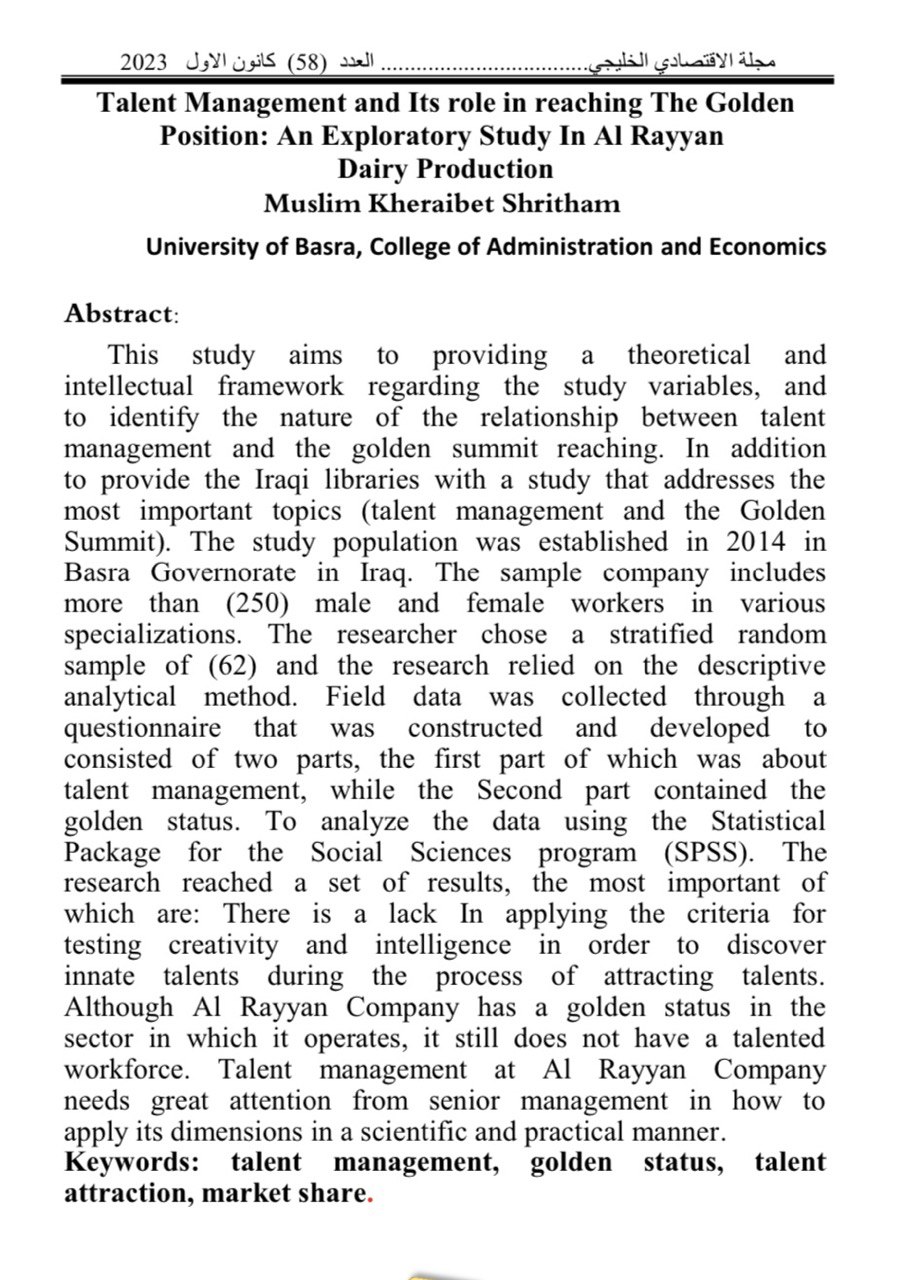Talent Management and Its role in reaching The Golden Position: An Exploratory Study In Al Rayyan Dairy Production
Main Article Content
Abstract
This study aims to providing a theoretical and intellectual framework regarding the study variables, and to identify the nature of the relationship between talent management and the golden summit reaching. In addition to provide the Iraqi libraries with a study that addresses the most important topics (talent management and the Golden Summit). The study population was established in 2014 in Basra Governorate in Iraq. The sample company includes more than (250) male and female workers in various specializations. The researcher chose a stratified random sample of (62) and the research relied on the descriptive analytical method. Field data was collected through a questionnaire that was constructed and developed to consisted of two parts, the first part of which was about talent management, while the Second part contained the golden status. To analyze the data using the Statistical Package for the Social Sciences program (SPSS). The research reached a set of results, the most important of which are: There is a lack In applying the criteria for testing creativity and intelligence in order to discover innate talents during the process of attracting talents. Although Al Rayyan Company has a golden status in the sector in which it operates, it still does not have a talented workforce. Talent management at Al Rayyan Company needs great attention from senior management in how to apply its dimensions in a scientific and practical manner.
Article Details

This work is licensed under a Creative Commons Attribution-ShareAlike 4.0 International License.
References
Reference
AR, IM (2019). “e Impact of Green Product Innovation on Firm Performance and Competitive Capability: e Moderating Role of Managerial Environmental Concern”. Procedia - Social and Behavioral Sciences, 62, pp.854-864.
BOBILLO, A, LÓPEZ-ITURRIAGA, F & TEJERINA-GAITE, F (2020). “Firm performance and international diversification: e internal and external competitive advantages”. International Business Review, 19(6), pp.607-618
Calo, T. J. E. I. C. P. (2018). Talent Management in the Era of the Aging Workforce: The Critical Role of Knowledge Transfer. Public Personnel Management,37(4)p: 403
CANTELE, S & ZARDINI, A (2018). “Is sustainability a competitive advantage for small businesses? An empirical analysis of possible mediators in the sustainability efinancialper France relationship”. Journal of Cleaner Production, 182(17), pp.166-176
Downe, Alan G., Loke, Siew-Phaik, Ho, Jessica Sze-Yin, Taiwo, Ayankunle Adegbite, m , " Corporate Talent Needs and Availability in Malaysian Service Industry " , International Journal of Business and Management, Vol. (7), No. (2), (2020)
GAMERO, L, AZORÍN, M & CORTÉS, C (2019). “e whole relationship between environmental variables and firm performance: competitive advantage and firm resources as mediator variables”. Journal of Environmental Management, 90(10), pp.3110-3121.
Garavan, T. N., Carbery, R., and Rock, A. (2021). Mapping Talent Development: Definition, Scope and Architecture. European Journal of Training and Development, 36(1)p: 5
Hartmann, E., Feisel, E. & Schober, H., ‘‘Talent management of western MNCs in China: balancing global integration and local responsiveness’’, Journal of World Business, Vol. (45) No. (2), (2020).
Higgins, B. (2020). An Analysis of the Effects of Integrated Instruction of Metacognitive and Study Skills Upon the Self-Efficacy and Achievement of Male and Female Students. (Master Thesis) Miami University, pp.2-63.
HIU, CN & Yang, CL (2018). “Competitive Advantage and Simultaneous Mutual Influences between Information Technology Adoption and Service Innovation: Moderating Effects of Environmental Factors”. Journal of
James A. Cannon, Rita McGree, " Talent Management and Succession Planning " , Chartered Institute of Personnel and Development, London, UK , (2021) .
KHAN, K, XUEHE, Z, ATLAS, F & KHAN, F (2019). “e impact of dominant logic and competitive intensity on SMEs performance: A case from China”. Journal of Innovation & Knowledge, 4(1), pp.1-11.
KIM, H & HOSKISSON, R (2018). “A Resource Environment View of Competitive Advantage”. Emerging Economies and Multinational Enterprises Advances in International Management, 28(95), pp.140.
LIAO, Z (2020). “Temporal cognition, environmental innovation, and the competitive advantage of enterprises”. Journal of Cleaner Production, 135(3), pp.1045-1053.
Lawler, E. E., III. (2018). Talent: Making People your Competitive Advantage. San Francisco, CA US:Jossey-Bass Hills, A. 2009. Succession planning — or Smart Talent Management?. Industrial and Commercial (12) Training, 41(1):p03
LI, G, WAN, X, SU, S & SU, Y (2019). “How green technological innovation ability influences enterprise competitiveness”. Technology in Society 2(4), pp.1-21.
Lyria, R. K. (2021). Thesis on Effects of Talent Management on Organization performance in Companies Listed in NSE in Kenya submitted to Jomo Kenyatta University of Agriculture and Technology for the award of Doctorate degree of Philosophy in Human Resource Management
MOLINER, P, AZORÍN, M & ORTEGA, P (2020). “e Holy Grail: Environmental management, competitive advantage and business performance in the Spanish hotel industry”. International Journal of Contemporary Hospitality Management, 27(5), pp.714–738.
MUKARTO SISWOYO, (2020), Competitive Advantage of Environmental Management and Green Innovation, DOI: https://doi.org/10.5281/zenodo.p415.584
Mwangi, W. (2019). Factors affecting talent management at Nation Media Group. Masters report, Strathmore Business School, Strathmore University, Nairobi.
Noe, Raymond et al., "Human Resource Management : Gaining A competitive Advantage" 6th Edition, McGraw-Hill Irwin, New York, (2018)
Pruis, E., " The five key principles for talent development " , Industrial and Commercial Training, Vol. (43), (2021(.
Redalyc: https://www.redalyc.org/articulo.oa?
RUA, O, FRANÇA & ORTIZ, RF (2021). “Key drivers of SMEs export performance: the mediating effect of competitive advantage”. Journal of Knowledge Management, 22(2), p257 .279.
SINGH, SK, CHEN, J, GIUDICE, MD & EL-KASSAR, AN (2019). “Environmental ethics, environmental performance, and competitive advantage: Role of environmental training”. Technological Forecasting and Social Change, 146(30), pp.203-211.
SINGJAI, K, WINATA, L & KUMMER, TF (2020). “Green initiatives and their competitive advantage for the hotel industry in developing countries”. International Journal of Hospitality Management, 75(14), pp.131-143.
Tarique, I., and Schuler, R. (2019). Global Talent Management Literature Review, Integrative Framework, and Suggestions for Further Research. Journal of world business, 45(2):p 105
Zhang, Shuai,& Bright, David, "Talent definition and talent management recognition in Chinese private-owned enterprises", Emerald Group Publishing Limited, Journal of Chinese Entrepreneurship, Vol. (4), No. (2), (2018) .
